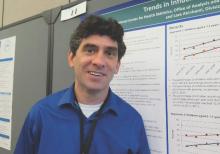SAN DIEGO – The proportion of children with asthma receiving the influenza vaccine has continued to increase in the past decade or so, though not as quickly as for children without asthma, results from national survey data found.
While the influenza vaccine is recommended for all children aged 6 months and older, trends in influenza vaccination for early (August-October) versus late (November-May) vaccination in children with asthma have not been examined, lead study author Dr. Alan E. Simon said during a poster session at the annual meeting of the Pediatric Academic Societies.
Dr. Simon, a medical officer with the office of analysis and epidemiology at the National Center for Health Statistics, Hyattsville, Md., and his associates evaluated National Health Interview Survey (NHIS) sample child files for 2005-2013. They limited the analysis to children aged 2-17 years and defined current asthma as a “yes” response to two questions: “Has your doctor ever told you that your child has asthma?” and “Does your child still have asthma?” A total of 31,668 NHIS interviews conducted between April and July 2005-2013 were assessed for vaccine receipt between August and May of the previous flu season. The researchers conducted logistic regression with predictive margins with receipt of flu shot as the dependent variable, and year, current asthma, and the interaction between year and asthma as dependent variables.
Dr. Simon reported that the percentage of children with asthma who received a flu shot increased an average of 3.2 percentage points per year during the time period, reaching 55% in 2012-2013. At the same time, the percentage of children without asthma who received a flu shot increased an average of 4.2 percentage points per year, reaching 45% in 2012-2013. Meanwhile, the percentage of children in both groups who received early vaccination increased about 1.5% per year, reaching 32% in children with asthma and 27% among children without asthma in 2012-2013.
The researchers also found that over the last three flu seasons, the following characteristics were predictive of children with asthma having a longer time to vaccination or a lower probability of vaccination: being aged 12-17 years vs. 2-5 years (adjusted hazard ratio of 0.75; P less than .01); being uninsured vs. privately insured (aHR 0.52; P less than .01), and living in the South or the West vs. the Northeast (aHR 0.79; P less than .05).
Dr. Simon said that similar overall results were observed when he and his associates conducted a separate analysis that assessed 85,087 NHIS interviews from 2005 to 2013 and used Kaplan-Meier survival statistics to estimate yearly vaccination estimates and early vaccination estimates.
The study was funded by the Centers for Disease Control and Prevention. Dr. Simon reported having no relevant financial conflicts.
On Twitter @dougbrunk


